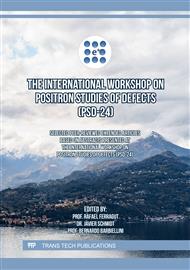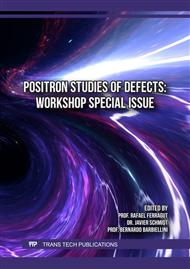p.63
p.69
p.79
p.87
p.103
p.119
p.125
p.135
p.145
Amorphous PbO Photoconductive Film Structure Revealed by Variable-Energy, Doppler-Broadened Positron Annihilation Spectroscopy
Abstract:
Photoconductive amorphous selenium (a-Se) layers are utilized in flat panel X-ray imaging detectors as a direct conversion medium, converting X-ray photons directly into electric charge. Commercial a-Se direct conversion Active Matrix Flat Panel Imagers (AMFPIs) have demonstrated superior image quality in mammography, showcasing the potential of this X-ray imaging technology [1-2]. The use of a-Se is limited, however, by its low Z, resulting in low stopping of high energy X-rays [2]. This limitation is not shared by PbO thin films. Earlier PbO films consisted of small poly-crystalline platelets with low film density and suffered from the presence of both oxygen vacancies and impurity phases (PbO2). Recent advances [3-4] have yielded dense amorphous PbO (a-PbO) films with apparently uniform stoichiometry, as confirmed by X-ray photoelectron spectroscopy (XPS). More careful analysis [5] using X-ray absorption spectroscopy (XAS) indicated some tailing of the conduction band, which was attributed to suspected O-vacancies. An annealing study on a-PbO [3] indicated a transition to β-PbO around 500 C. X-ray diffraction (XRD) data of the β-PbO (annealed a-PbO) film matched that of a β-PbO reference, while XAS data did not. This was attributed to the different depths of the sample volumes probed by the two techniques. Doppler-broadened positron annihilation spectroscopy (DBPAS) was conducted on several a-PbO samples synthesized under different conditions using the McMaster Variable-Energy Positron Beam (MVEPB) and the results were modelled using VEPFIT [6]. All samples were found to have a three-layer structure, with the bulk S-parameters between 0.4725 and 0.4753. The two other layers were contained within the first 300nm of the film and varied in thickness, diffusion length and S-parameter value. This confirms the suitability of DBPAS, as a sensitive probe of vacancy-type defects and the layer structure of thin films, to guide the optimization of a-PbO synthesis for photoconductive detectors. Work is underway to produce a series of samples which vary systematically in their synthesis conditions to establish synthesis-structure relationships.
Info:
Periodical:
Pages:
103-118
Citation:
Online since:
July 2025
Price:
Сopyright:
© 2025 Trans Tech Publications Ltd. All Rights Reserved
Share:
Citation:



